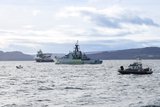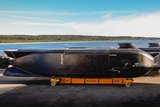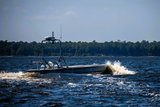Royal Navy’s new Dreadnought SSBNs to be equipped with OSI’s ECPINS
The fifth and latest Astute-class SSN, commissioned in 2022, was the HMS Anson, which started sea trials in 2023. (Photo: Royal Navy)
A total of two contracts, signed between OSI and BAE, will ensure the continuation of OSI’s submarine navigation system for the Astute-class SSNs and will incorporate the system for the UK’s Dreadnought-class of SSBNs. OSI’s ECPINS submarine navigation system has already been in use fleetwide across the UK’s Royal Navy.
OSI stated that ECPINS enables navigation in harsh subsurface environments and fast tactical situations while minimising above-water signature through algorithmic calculations instead of mostly relying on sensors.
The construction of seven new Astute-class SSNs for the UK Royal Navy has been underway with the new boats set to replace the remaining Trafalgar-class SSNs still in service.
Related Articles
Fifth Astute-class nuclear submarine sails for the first time
UK and Australian defence deal agreed as BAE wins nuclear submarine contract
Radar training simulators for German Navy Engineering School pass FAT
The UK’s Astute-class SSN programme has suffered significant cost increases and delays. The boats, however, offer a considerable capability increase over the earlier Trafalgar-class and Swiftsure-class SSNs. A contract was awarded in 1997, but the first boat did not enter service until 2010. Five have been commissioned, with the last two to be delivered before 2026. Powered by a nuclear reactor, the boats have a 25-year lifespan without being refuelled.
Displacing 8,600t, the Astutes are 97m-long and powered by a PWR2 nuclear reactor and MTU 600 diesel generators, giving them an unlimited range and a top speed of 30kt. According to OSI, the Astute-class can circumnavigate the globe submerged by generating water and oxygen.
The UK has been building four new Dreadnought-class SSBNs for the Royal Navy that will take over the nuclear deterrent role from the existing four Vanguard-class submarines. Previously known as the Successor programme, the Dreadnought boats will be built in BAE Systems Submarine Solutions yard in Barrow, with the first expected to enter service in the 2030s.
The Dreadnaught-class is being purpose-built as a nuclear-powered ballistic missile carrier. The class has been announced to displace 17,200t and measure 153.6m in length. Fitted with a PWR3 nuclear reactor from Rolls Royce, turbo-electric drive and pump-jet, the boats have an unlimited range restricted only by the need to sustain the 130 crew.
Related Equipment in Defence Insight
More from Naval Warfare
-
![How the Anduril-HHI autonomous ship plan fits in with the US Navy’s MASC programme]()
How the Anduril-HHI autonomous ship plan fits in with the US Navy’s MASC programme
The new modular vessel is expected to be developed for both commercial and defence use, with a heavy focus on production speed and mission flexibility.
-
![Indo Pacific 2025: Autonomous systems reigned but can the Australian Defence Force afford it?]()
Indo Pacific 2025: Autonomous systems reigned but can the Australian Defence Force afford it?
Multiple autonomous systems and technologies were on display at this year’s Indo Pacific, but questions remain over how the Australian Department of Defence will balance the books.
-
![US Navy starts acquisition process for uncrewed maritime systems for support missions]()
US Navy starts acquisition process for uncrewed maritime systems for support missions
The USN is interested in uncrewed capabilities that can carry out explosive ordnance disposal, mine countermeasures, force protection, ISR and anti-submarine missions.
-
![What capabilities has the US deployed in the Caribbean and South America to engage “drug boats”?]()
What capabilities has the US deployed in the Caribbean and South America to engage “drug boats”?
The US arsenal includes amphibious assault and littoral combat ships, cutters, destroyers, landing platform docks, a nuclear-powered fast attack submarine, drones, ISR aircraft, helicopters and fighters.























